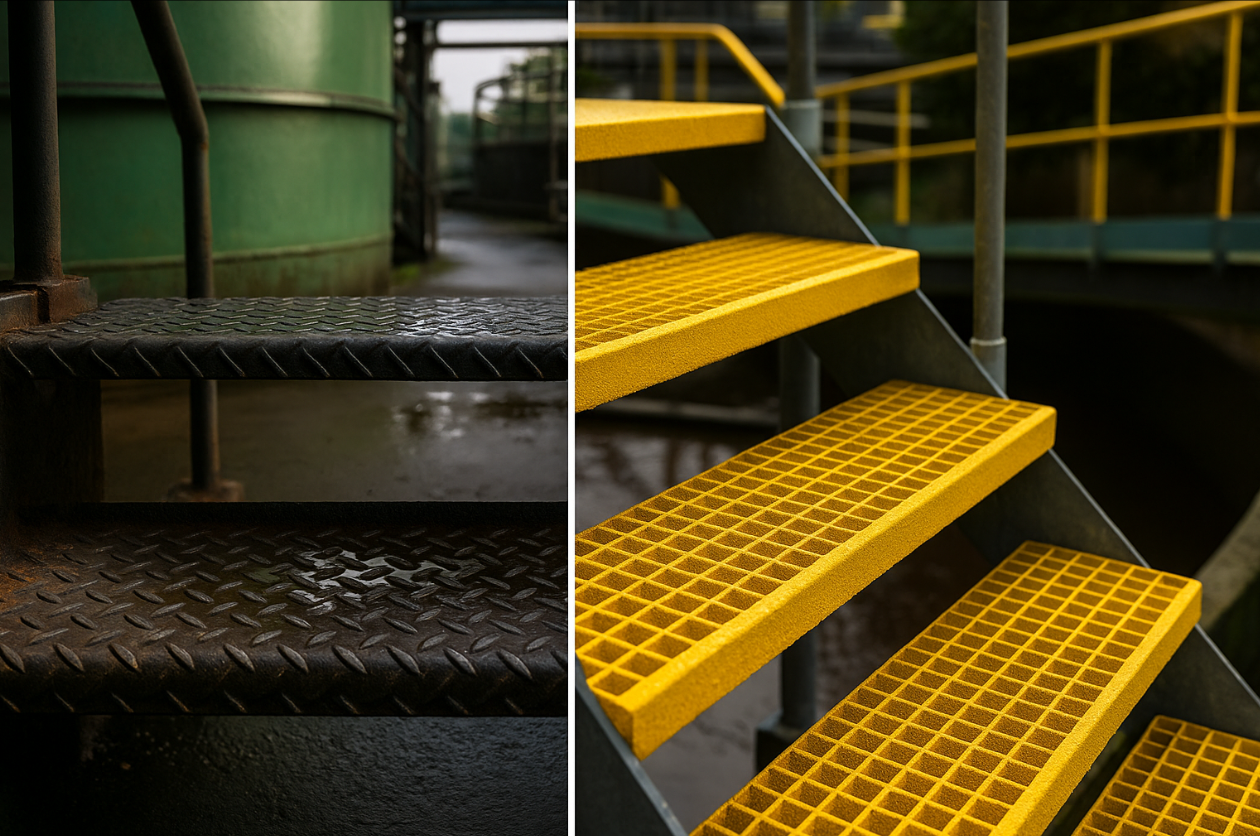Introduction
Choosing the wrong stair‑tread material can cost you much more than the price of replacement parts—it can shut down production, injure workers, and derail project timelines. Industrial sites from wastewater plants to electrical substations now compare fiberglass grating stair treads directly with painted carbon‑steel plates because they need safer footing, lower maintenance, and predictable life‑cycle costs.
Unicomposite, an ISO‑certified pultrusion specialist with decades of shop‑floor experience, supplies FRP profiles and custom fabrication to global OEMs. That hands‑on knowledge shapes the comparison below so that you can decide which material protects your people and your bottom line.

fiberglass grating stair treads
Material Performance Under Real‑World Loads
Fiberglass composites behave differently from metals. Understanding those differences is critical when safety audits and insurance premiums are on the line.
Slip Resistance & Traction in Wet or Oily Areas
Factory catwalks and clarifier tanks rarely stay dry. Molded‑in grit on fiberglass walking surfaces delivers an average Coefficient of Friction (COF) of 0.65 when wet, comfortably above OSHA’s recommended 0.50. A recent field test at a Gulf Coast petrochemical site recorded 42 % fewer slip reports after swapping steel diamond plate for composite stair treads.
Load Capacity, Deflection Limits & Impact Strength
A 38 mm‑thick fiberglass grating stair tread with 40 % glass content typically supports 3.0 kN m² live load at L/200 deflection, verified under ASTM E119. Impact energy absorption reaches 21 kJ m²—three times the value of mild steel—meaning dropped tools bounce rather than dent. When heavier wheel traffic is expected, Unicomposite engineers adjust glass‑roving orientation to raise load capacity by up to 25 % without adding weight.
Life‑Cycle Cost & Maintenance
Price per pound means little if the part corrodes out in five years.
Corrosion Resistance in Chemical, Coastal & Waste‑Water Environments
Vinyl‑ester resin systems in FRP resist pH 1‑14 solutions, sodium hypochlorite, and salt‑spray exposure beyond 10 000 hours ASTM B117 with no blistering. A North Sea drilling platform documented zero thickness loss after eight years of ocean exposure, while adjacent galvanized steel ladders required two recoats and partial replacement.
Routine Cleaning, Inspection Intervals & Expected Service Life
Composite treads wash down with standard detergents; no repainting, galvanizing, or anti‑skid tape is required. Annual inspections focus on anchor bolts, not the tread body, and owners report service lives of 25–40 years—roughly double that of painted steel in the same environment. A lifecycle analysis by Jacobs Engineering placed net present cost at 34 % lower for fiberglass when maintenance labour and downtime were included.
Installation & Fabrication Flexibility
Contractors appreciate materials that save crane hours and change‑order headaches.
Weight, Handling, and Crew Requirements on Site
At only 4.5 lb ft², fiberglass grating stair treads weigh one‑quarter of steel plate. Two workers can carry a 12‑ft stringer section without rigging, trimming pieces on site with carbide blades. Faster installation shaved 18 crew‑hours from a recent cooling‑tower retrofit, according to the GC’s close‑out report.
Customization Options: Molded Nosings, Color Coding, Dielectric Safety
Pultrusion allows bright‑yellow nosings to be molded integral to each tread, eliminating bolted‑on aluminum strips that loosen over time. Color‑coding steps for egress routes boosts visual safety cues, while the material’s dielectric strength (> 25 kV mm) prevents step‑through electrical faults near switchgear.
“Because we control resin formulation in‑house, we can embed quartz grit or carbon veils at the pultrusion die, not afterward,” notes Wang Lei, senior process engineer at Unicomposite.
Compliance, Safety Standards & Proof of Performance
Facility managers must document that components meet both regulatory and corporate standards.
Meeting OSHA, ANSI A1264.1, and ISO 9001 Expectations
Fiberglass stair treads produced under ISO 9001 management systems come with mill test certificates, COF test sheets, and load‑deflection charts. This documentation simplifies OSHA inspection prep and helps specifiers satisfy ANSI A1264.1 guidelines for slip resistance on walking‑working surfaces.
Case Study (Anonymized): Waste‑Water Plant Retrofit Cut Downtime 40 %
A Midwestern municipal wastewater facility replaced rusted checker‑plate stairways across five basins. The FRP retrofit required just one weekend shutdown versus the two‑week outage budgeted for steel. Maintenance logs show unscheduled downtime fell by 40 % over the next 24 months due to elimination of corroded fasteners and anti‑skid tape failures.
Decision Matrix: When Steel Still Makes Sense—When Fiberglass Wins
High‑Temperature, Heavy‑Traffic Scenarios Favoring Steel
Forge plants that run floor temperatures above 120 °C or concentrate multi‑ton forklift traffic still lean on steel plate for its heat tolerance and point‑load capacity. In these zones, schedule preventive recoats every 18 months to contain corrosion.
Corrosive, Remote, or Electrically Sensitive Sites Favoring Fiberglass
Remote solar farms, desalination plants, and pulp‑and‑paper bleaching decks choose fiberglass grating stair treads for their self‑finishing surfaces, dielectric behavior, and logistics savings. Dropping transport weight by 75 % means smaller cranes or even helicopter lifts in difficult terrain.
Conclusion
Selecting the best stair‑tread material hinges on slip resistance, lifecycle cost, installation logistics, and compliance evidence. Steel retains a niche in extreme heat or ultra‑heavy loads, but for most corrosive or remote industrial settings, fiberglass delivers safer footing and lower total cost. Contact Unicomposite’s engineering team to review drawings, request test data, or secure a tailored quotation.
Frequently Asked Questions
Q1. Can fiberglass treads be cut to fit unusual stair widths on site?
Yes. Standard carbide or diamond blades make clean cuts; seal the edges with compatible resin and you maintain full corrosion resistance.
Q2. How long does it take to receive custom‑colored stair treads?
Lead times for non‑stock colors average three to four weeks, including mold setup and pultrusion cure cycles.
Q3. Will UV exposure fade the color?
Gel coats with UV inhibitors keep color shift below ΔE 0.9 over five years of Florida exposure, verified by Q‑SUN accelerated testing.
Q4. What certifications come with the product?
Each shipment includes ISO 9001 compliance certificates, ASTM E119 load‑deflection data, slip‑resistance tests, and a material safety data sheet.
Q5. Is FRP recyclable at end of life?
Fiberglass composites can be ground for cement‑kiln co‑processing or feedstock in asphalt fillers, keeping waste out of landfills.
 info@unicomposite.com
info@unicomposite.com


























